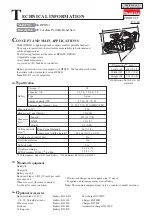
saw.
Do n o t o ve rre a c h .
Use a support table or have a helper or “tailman” take stock away from the back side of the
blade.
Ho u s e ke e p in g .
Before turning on machine, remove all extra equipment such as keys, wrenches, scrap, and
cleaning rags away from the saw.
Ca re le s s a c ts .
Give the work you are doing your undivided attention. Looking around, carrying on a
conversation, and “horseplay” are careless acts that can result in serious injury.
Dis c o n n e c t m a c h in e
before performing any service or maintenance or when changing blades. A machine
under repair should be RED TAGGED to show it should not be used until the maintenance is complete.
Alig n m e n t.
Check the alignment of the splitter, fence and miter slot to the blade. A caution decal is installed on
each guard and splitter to remind the operator of the dangers of mis-alignment.
Ma in ta in to o ls in to p c o n d itio n .
Check the saw blade for cracks or missing teeth. Do not use a cracked or
dull blade or one with missing teeth or improper set. Make sure the blade is securely locked on the arbor.
Ha n d s a fe ty.
Keep hands clear of the blade area. Do not reach past the blade to clear parts or scrap with the
saw blade running. Never saw free hand. Avoid awkward operations and hand positions where a sudden slip
could cause your hand to contact the blade.
S a fe ty d e vic e s .
Always use the splitter, blade guard, push stick and other safety devices for all operations
where they can be used. On operations such as dadoing or molding where the blade guard cannot be used, use
feather boards, fixtures and other safety devices and use extreme caution. Reinstall the splitter and blade
guard immediately after completing the operation that required their removal.
S a w b la d e ro ta tio n .
Be sure the saw blade rotates clockwise when viewed from the motor side (left side) of the
machine.
Ad ju s tm e n ts .
Make all adjustments to the machine and operational setup with the power off. Never remove the
insert with the blade running.
Ma te ria l c o n d itio n .
Do not attempt to saw boards with loose knots or with nails or other foreign material, on its
surface. Do not attempt to saw twisted, warped, bowed or “in wind” stock unless one edge has been jointed
for guiding purposes prior to sawing.
La rg e s to c k.
Do not attempt to saw long or wide boards unsupported where spring or weight could cause the
board to shift position.
J o b c o m p le tio n .
If the operator leaves the machine area for any reason, he should turn “off” the power to the
table saw motor and wait until the saw blade comes to a complete stop before his departure. In addition, if the
operation is complete, he should clean the table saw and the work area.
NEVER
clean off the table saw with power
“on” and
NEVER
use the hands to clear sawdust and debris; use a brush.
If yo u a re n o t
thoroughly familiar with the operation of this circular sawbench, obtain advice from your
supervisor, instructor or other qualified person.
Dru g s , a lc o h o l, m e d ic a tio n .
Do not operate this machine while under the influence of drugs, alcohol, or any
medication.
He a lth h a za rd s .
Some dust created by power sanding, sawing, grinding, drilling and other construction
activities contains chemicals known to cause cancer, birth defects or other reproductive harm. Some
examples of these chemicals are:
* Lead from lead-based paint.
* Crystalline silica from bricks and cement and other masonry products. *
Arsenic and chromium from chemically-treated lumber.
Your risk from these exposures varies, depending on how often you do this type of work. To reduce your
exposure to these chemicals, work in a well-ventilated area, and work with approved safety equipment, such as
those dust masks that are specifically designed to filter out microscopic particles.
3
HM-TS250
250MM CIRCULAR SAWBENCH
VER 07-07-2013



































